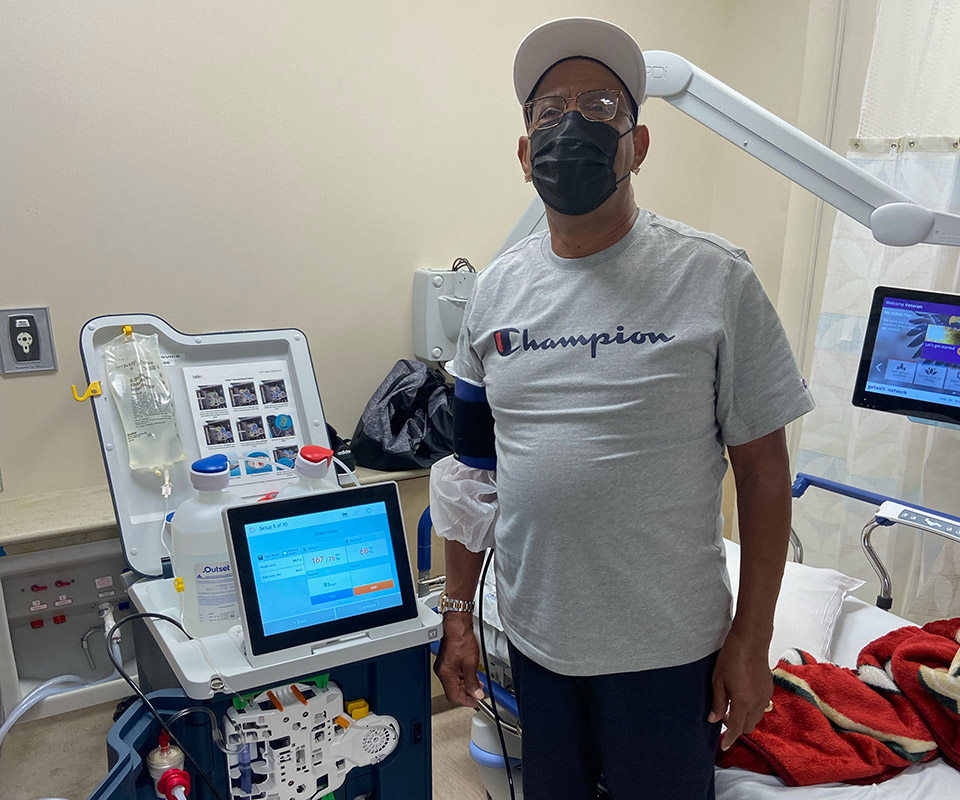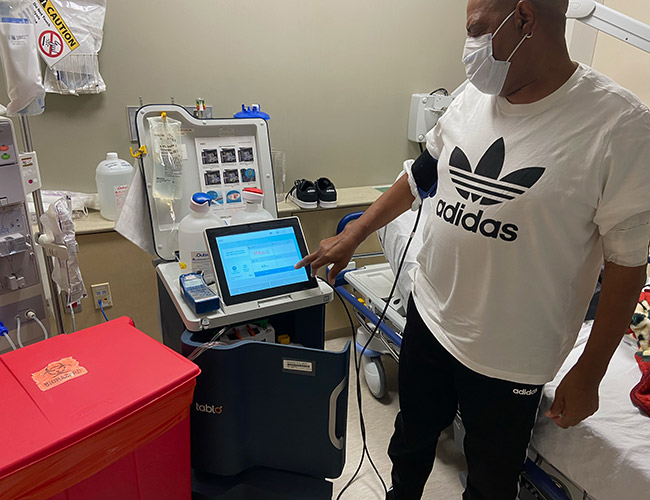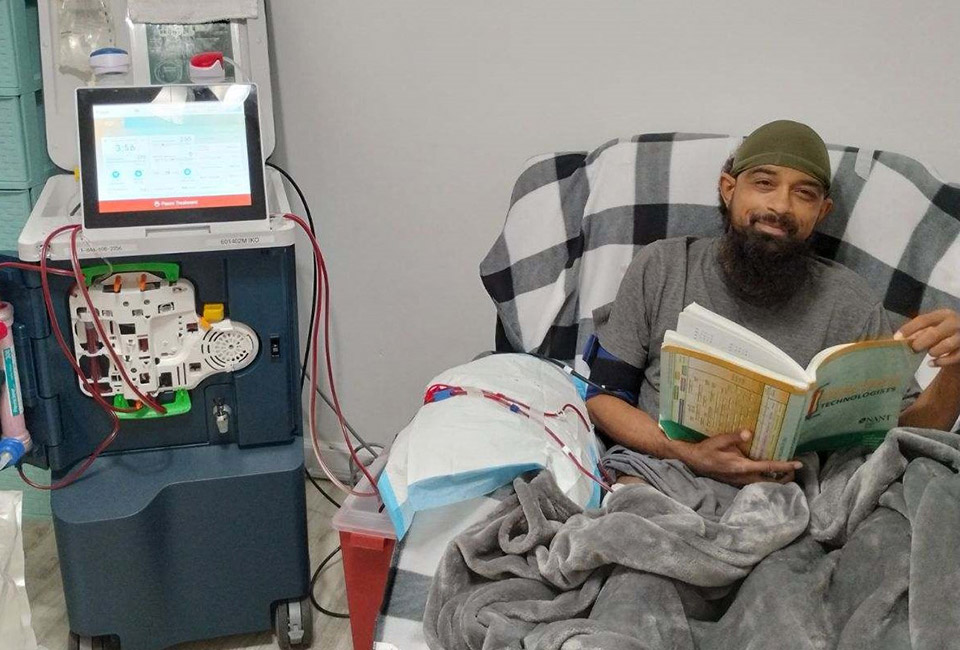U.S. Army Vet AJ’s Incredible Journey of Hope

Summary
After many years fighting drug and alcohol addiction, followed by kidney failure, AJ shares how he took an active role in his in-center dialysis and is enjoying a blessed life.
AJ, a 65-year-old U.S. Army veteran from Richmond, VA, is known for his positive and easy-going attitude, always greeting and joking around with patients and staff as he arrives for his hemodialysis treatments at the clinic. He has been on dialysis for his end-stage renal disease (ESRD; also known as end-stage kidney disease, or ESKD) for more than two years. Today, he is grateful for his clean, sober and blessed life, and hopes to be an inspiration to others after lifting himself out of a dark place.
AJ grew up on his family’s farm, where they grew vegetables and raised hogs. Health issues such as heart disease, high blood pressure, diabetes and alcoholism were common in his family, and AJ followed along the same path. He spent many years battling alcoholism, drug addiction and smoking. Nearly a decade ago, he had enough of drinking and drugs, and quit both, and then stopped smoking and underwent triple bypass surgery last year. He has also had insulin-dependent Type 2 diabetes for the past 20 years.
Around the time that he won his fight against drugs and alcohol, AJ began another health journey. He started feeling bad physically, and went to his doctor, who ran some tests and told him that his kidneys weren’t working well. He was referred to a nephrologist who said that based on his kidney function, he would eventually need dialysis. AJ didn’t understand how this could be happening, as he still felt ok, was still producing urine and didn’t want to stop working. He fought it for years. But then he continued to feel worse. He talked about it with a close cousin who was on dialysis, and he encouraged AJ to start treatment. AJ retired from the Army in June 2019, when he was 62, and had fistula surgery the very next day.
AJ began in-center dialysis treatment in January 2020, and his first year and a half was not an easy experience. He traveled to the clinic three days a week for his treatments, that the staff performed using a traditional dialysis machine.
“After my treatments on the old machine, I often didn’t feel well” says AJ.
“I was drained. I would sometimes have to sit around for up to an hour before I could drive home. There were times when I had to ask someone to come pick me up. And I would often have painful cramping during treatment.”
His usual post-treatment routine during that time included going straight to bed when he got home, sleeping the rest of the day, laying around the following day to recuperate, and then going to the clinic to do it all again the next day. AJ felt like his quality of life had been taken from him, and there were many times that he seriously considered discontinuing dialysis altogether. He would rather deal with the inevitable than feel the way he did.
Fast-forward a year, and AJ’s experience, attitude and outlook changed on one momentous day. In early 2021 as he arrived for his usual treatment, clinic staff introduced him to a new dialysis machine, the Tablo® Hemodialysis System. They asked if he would be interested in trying it. Always wanting to learn more about his dialysis and how the equipment works, and in tune with his body’s response to treatment, AJ jumped without hesitation at the opportunity to try something new.
AJ now arrives for his four-hour treatments on Monday, Wednesday and Friday mornings with a smile on his face and a swagger in his step. After checking in and having his weight and temperature taken, he goes into his treatment area and takes over. For the first time, AJ is able to take an active, hands-on role in his in-center treatments.

After a brief training period, he now confidently helps set up his treatments with nurse supervision, using the system’s simple-to-use touchscreen with conversational text, illustrations and video instructions. He starts by taking his standing and sitting blood pressure, and then Tablo, that is already partially set up for him by the staff, instructs him via the touchscreen to take a water sample to test for chlorine/chloramines, take a dialysate sample to test the conductivity and pH, and prime the machine.*
Once these steps are completed, a nurse then cleans and prepares his access site in his upper left arm, and begins the treatment. While reclined in a bed during his dialysis, AJ usually listens to music or watches TV. His treatment data is recorded automatically via two-way wireless data transfer and cloud-based monitoring and reporting.
“Since I’ve been on Tablo, it’s like night and day. I haven’t cramped, or felt bad after treatment.”
“Since I’ve been on Tablo, it’s like night and day. I haven’t cramped, or felt bad after treatment,” says AJ. “The machine is easy, the touchscreen walks you through everything. When I’m done with my treatments, I’m usually feeling good. I can pick and choose what I would like to do with my day, and I like that. And I’ve learned to manage my fluid intake. I honestly feel that I’m living my best life.”
AJ enjoys spending his free time on hobbies and activities that are important to him—things that he thought he would never be able to do again. He enjoys restoring his treasured 1978 Corvette 25th Anniversary Edition, walking his Rottweiler named Footz, gardening in his large yard and going fishing. He also enjoys watching his two grandsons play on their basketball and football teams—something he used to miss when he wasn’t feeling well after his treatments. He is thankful for the love and support of his family, including daughter Alinza and his significant other, Tangy, for being by his side through all of his ups and downs.
He’s also happy to be an inspiration to others. “I’m blessed to be here, I really am. It feels like a dream. I want to help other folks who don’t realize what they’re doing to their body when they’re on drugs, or when they get kidney disease. I’ve been through both.”
* Notes:
AJ’s treatments are done under nurse supervision. Tablo makes dialysate from concentrations of acid and bicarbonate, and while Outset Medical does not require additional testing of conductivity or pH, if desired per a site’s policies, dialysate samples can be taken and tested. A recent study notes that in-center self-care hemodialysis empowers and activates patients, providing more flexibility in their dialysis schedule and, by virtue of their self-care training, more knowledge about their therapy and their overall management including fluid management, dialysis time and frequency.
Tablo Hemodialysis System Disclaimer: Results may vary. Keep in mind that all treatment and outcome results are specific to the individual patient. Please consult your physician for a complete list of indications, warnings, precautions, adverse events, clinical results, and other important medical information. It is important that you discuss the potential risks, complications, and benefits of this product with your doctor prior to receiving treatment, and that you rely on your physician’s judgment. Only your doctor can determine whether you are a suitable candidate for this treatment.
For safety and effectiveness information, indications for use, risks, cautions and warnings, please refer to the product labeling for the Tablo Hemodialysis System.

